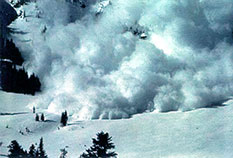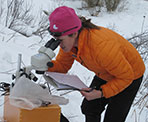Revisions: Original 1996. Reformatted in 2013. Revisions 2016. Minor additions and reformated 2019
Reproduction Information: you are welcome to provide links to this page or to use short quotations and paraphrases in other documents as long as they appropriately reference the source. There is no charge for non-profit organizations to reproduce or publish extensive parts or all of this paper, but please obtain advanced permission from Ron Watters (wattron@isu.edu). Photo credits: US Forest Service & Ron Watters.
Avalanche Safety in the Backcountry
These are just some very quick and dirty suggestions for travel in the winter backcountry. You can find more information about these and other safety considerations from the excellent resources listed at the end of this paper.
Safety Considerations
- Most avalanches start on slopes that are 30 degrees or greater. If you stay off of
30 degree (and greater) slopes and avoid traveling beneath them, your risk is greatly minimized.
- Remember the key red flag indicators:
- Recent avalanches? Absolutely and unequivocally no doubt. It's dangerous out there.
- Significant new snow over the last 24 hours? Again no doubt: expect hazardous conditions.
- Has it been windy? Wind moves snow from windward slopes to leeward slopes. It can move lots and lots of snow quickly, creating - you guessed it - slabs. If it's been windy, watch those lee slopes.
- Collapsing of the snow or whoomping sounds? Serious instabilities exist in the snow pack. Danger is high.
- Cracks running out in front of you? Perfect conditions for slab avalanches. Danger is high.
- Sudden temperature rise. Water oils the avalanche machinery and all bets are off. Danger is high.
- A reminder: avalanche danger is greatest during and shortly after intensive snow falls. Traveling on or below 30 degree slopes during intensive storms is very dangerous. (Intensive storms are those in which 1" of snow falls per hour)
- Wind moves snow from windward to leeward slopes and can create the same kinds of unsafe conditions created by an intensive snow fall. Stay off leeward slopes during and shortly after periods of strong winds. Instabilities can remain for long periods. Avoid lee slopes if you can or use extreme caution otherwise.
- Watch for the leeward pockets. In much of interior west, many of the mid and low elevation slopes have a lot of sagebrush showing, but every so often there are pockets—sides of gullies, steep short slopes and back sides of ridges—where the wind has deposited snow. Plan your route to avoid these areas. In the Pocatello, Idaho area alone, 6 deaths can be attributed to people being caught in short avalanches that occurred in leeward pockets.
- One extremely dangerous time in the mountains occurs when a period of cold weather is followed by a sudden warming trend or rain falling on the snow pack. Free water in the snow pack lubricates weak layers and often large avalanches result. Like intensive storms, it is a very dangerous time to be traveling in the mountains.
- Heavy trees provide protection from avalanches, but the trees must be spaced within 3 meters of one another. That's close enough to make skiing annoying. Sparse trees do NOT provide any more protection than open slopes.
- In the spring, big wet, damaging avalanches can occur. The safest time to travel is in the morning after a cold, clear night when the snow is frozen. Get off of steep slopes when the snow begins to soften from melting.
Traveling Considerations
- Traveling alone is risky: two is better, three is better yet.
- Use ridge lines, heavy trees, windward sides or low angle slopes (less than 30 degrees) to minimize your exposure.
- When crossing suspected avalanche slopes, do so one person at a time.
- If the first person gets across a suspected slope successfully, all remaining members of the party should use the same path. (The assumption is that the first person may have avoided parts of the suspected slope that could trigger an avalanche. Another individual setting off on a different path might hit one of the trigger areas. Thus, follow the same path.)
- Travel from island of safety (a group of heavy trees, a ridge top, etc) to island of safety.
- Don't camp, eat lunch and rest below obvious avalanche paths.
- Carry emergency avalanche equipment: transceiver, portable shovels, probe poles, compass with inclinometer, and hand lens. At the beginning of each winter season practice with your transceiver. Know how to use it before you need to use it.
- If you are moving up or down a suspected slope, stay to the side. If an avalanche occurs, the snow may move slower on the flank and allow escape.
- Stay out of gullies. They are natural pathways for avalanches and often fill deeply with snow when an avalanche occurs.
- Know what's out there. Check the avalanche forecast before leaving on a backcountry trip.
Other Resources
Staying Alive in Avalanche Terrain by Bruce Tremper. Tremper is the man. If you get one book on avalanche safety, this is the one to get.
Avalanche Essentials by Bruce Tremper. This is a more compact, shortened version of Tremper's Staying Alive book above. If you would like a reference book that is simple and to the point, this is the one for you.
Ken Libbrecht's Field Guide to Snowflakes. Ken Libbrecht is a physicist and the high wizard of snow crystals.
Snow Sense by Alaskans Jill Fredston and Doug Fesler. This small guide is easy to understand and very sense-able (sorry, couldn't resist).
Course Website. I maintain a course website to along with the course that I teach at the university. Here's a link to that site:
.
https://www.ronwatters.com/Avalanche.html
[END] |


